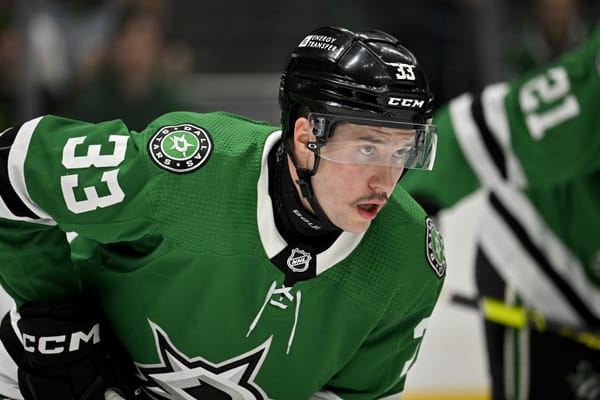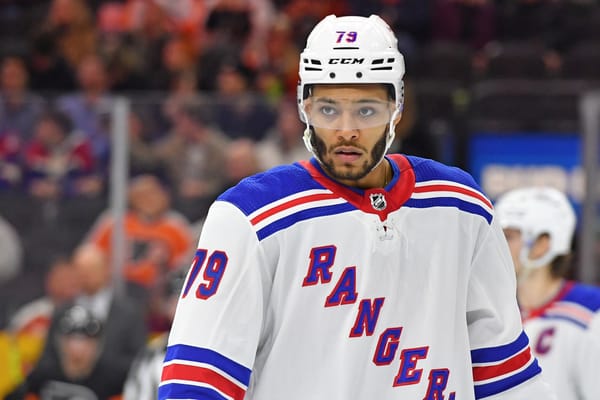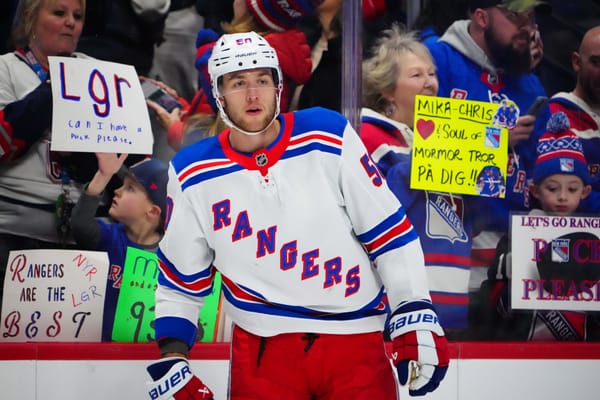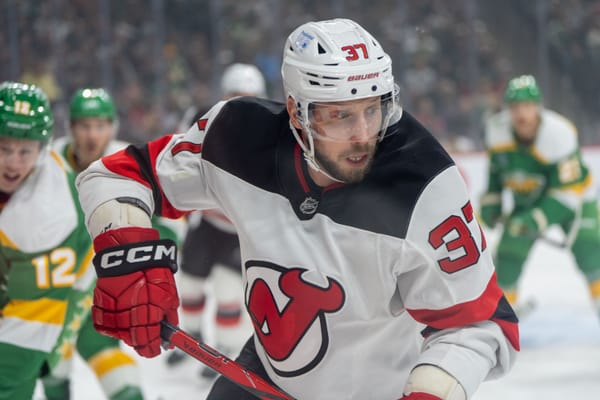The Next Few Months Are Some of the Most Important of Jeff Gorton’s Tenure
Whether he intended to or not, Jeff Gorton made a statement at the trade deadline with the moves he did and didn’t make. Now, the actions he takes over the next few months are going to be some of the most important of his tenure.
If you are saying to yourself that you feel you’ve heard that line before, there’s a good chance you have, but it bears repeating when you consider the state the Rangers are in.
Since releasing a letter to the fans in February of 2018, the Rangers have been deliberate in their process of moving players out, accumulating assets, clearing cap space, and making moves they felt were right for the team. Some of these moves include, but are not limited to, signing Artemiy Panarin, trading for and extending Jacob Trouba, trading for Adam Fox, and so on.
The decision to extend Chris Kreider for seven years at $6.5 million on average per year is a risky one — a deal in which the long term effects will be evaluated in the coming days — and one that will force the team to make corresponding moves in the long term. Trading Brady Skjei and the four remaining seasons at $5.25 million per to the Carolina Hurricanes can be considered a first step, and you can count on other moves of consequence to be made between now and opening night in October of 2020.
Sources say the Hurricanes have acquired Brady Skjei #NYR
— Shayna (@hayyyshayyy) February 24, 2020
How Gorton proceeds is critical, because he will have to walk a tight rope. The Rangers’ GM needs to keep an eye on the future — one that has the team continuing to make incremental improvements — and do so in a manner in which he isn’t trying to push things too far ahead too quickly.
There isn’t a Panarin move to be made this summer, although it wouldn’t be shocking to see if there are Trouba situations in which they acquire an RFA that’s worn out their current situation. But overall, any further movement will require him to make a determination of who on the current roster has a future contending for the Stanley Cup, and who doesn’t project to be a good fit.
At season’s end, not including any salary cap increases, the Rangers will have eight roster spots to fill through re-signing existing players, promoting talent from within, signing free agents in July, or acquiring players via trade. Gorton currently has $14,391,867 to play with, of which a considerable amount could go to Ryan Strome, Tony DeAngelo, and Alexandar Georgiev. Other free agents include UFAs Jesper Fast, Greg McKegg, and Micheal Haley, and RFAs Brendan Lemieux and Phillip Di Giuseppe.
Additional funds will assuredly open up one way or another, and it remains to be seen if it will be $792,500, $8,500,000, or somewhere in between. The first number is Georgiev’s current cap hit, and the second is Henrik Lundqvist’s. One of the two will leave the team in the offseason, as there’s no way the three goalie rotation continues into the 2020-21 season. After practice Monday, the future Hall of Famer spoke on finishing out the rest of the season, but he acknowledged that a conversation about his future is coming.
For me personally, moving forward here at practice, playing, my obligation, my job is to come here and give it my all. That’s what I’ve been trying to do over the last few weeks and just be ready when I get an opportunity to play. And if I’m not playing, trying to be as supportive as possible to the guys that are playing. I think that’s what you should do.
My situation after the season will obviously have things to talk about your role and if you fit in this role. Right now, my focus is to work hard and be ready.
More Lundqvist: "I've been very open with management over the two years I've been through this process that if there comes a day where they feel like I'm not a good solution, let's talk about it, let’s be open about it. I know we're going to sit down after this season."
— Dan Rosen (@drosennhl) February 24, 2020
Outside of the goalie situation, the Rangers will certainly assess whether or not they will bring back their two arbitration eligible RFAs in Ryan Strome and Tony DeAngelo.
Strome in many ways is the easier of the two, because he’s one contract year away from unrestricted free agency. Signing him to a one-year deal would be the most logical solution if the Rangers are interested in keeping him for now, but it would be smart to see what teams are interested in acquiring him this summer. It’s been a career year and counting for Strome, but with the development of Filip Chytil, it isn’t out of the question for the young Czech to be centering the Blueshirts’ second line full time during the 2021-22 season at the latest. It isn’t that there isn’t value in players with the offensive output of Strome on the roster, but there needs to be a balance financially, and one that doesn’t block cheaper and potentially more effective talent, like Chytil, out of the top six.
Related
Filip Chytil Is A Key Part of The Future And Should Be Playing in Rangers’ Top Six
DeAngelo’s case is a much more interesting one, and just because Skjei is gone I wouldn’t assume that he’s going to get paid. While he’s another player having a career year, it is important for the Rangers not to re-enter a situation they just exited. In other words, they don’t want to do with DeAngelo what they did with Skjei by giving someone a big contract off of one stellar season.
Ordinarily the answer to dilemmas such as this would be a bridge deal, but I can’t see a scenario where there’s a true middle ground to be found. This past offseason the Rangers put the screws to DeAngelo, and he ultimately signed a one-year deal worth $925,000. In my mind, a bridge deal for DeAngelo would be in the ballpark of $3.5 million, and if offered that amount I think he’d take his chances with arbitration because he’ll be able to present a case that has him finish in the top 10 in scoring among defenders, and potentially the top five.
While arbitration is generally a very abrupt process in which a team states its case on why a player isn’t as valuable as they think, part of me feels that such a scenario wouldn’t bother him all that much given how strong a case he can make for himself. His heart on sleeves personality also lends me to believe that whatever the Rangers give him verbally, he can take, and go back at them with a case of his own. Ultimately I won’t be surprised one way or another, as there are strong cases for trading and keeping DeAngelo. Similar to Strome, it becomes a question of money, playing time, and an overall cost to performance ratio that works for the team.
Outside of this, Gorton will also need to make decisions on players like Brendan Smith (1-year, $4.35 million) and Marc Staal ($5.7 million). The remainder of the season will give both an opportunity to play increased minutes on the left side with Skjei gone, and the same could be said of Ryan Lindgren, although he’s someone who should remain in the picture for next season. But when it comes to Smith and Staal, ideally the Rangers would be better off having only one of them on the roster next season. Both are making significantly more than they are worth, and if they are unable to find a trade partner — something that shouldn’t be as hard if salary retention is involved — a buyout would likely follow.
Fast, who was not moved at the deadline, is another intriguing case, and I’d be interested to see if there’s talk of the two sides trying to work on an extension. The Rangers should avoid overpaying role players, but if Fast wants to stay and the price is right, there’s no harm in having him in a bottom-six role. I personally think he’s headed to July 1 for a big payday, which he deserves, and the Rangers kept him around because they felt there’s more value having him on the team the rest of the season as opposed to getting a fourth or fifth round pick. If a third round pick or better was offered, I don’t think Fast is still a Ranger, so for now we will have to wait and see.
As of today, the Rangers have a record of 33-24-4 with 70 points in 61 games, six points back of both Wild Card teams. The Columbus Blue Jackets have 76 points in 64 games and New York Islanders have 76 points in 61 games. The Rangers play the Islanders tonight, and will face off vs. the Philadelphia Flyers on Friday and Sunday, the team currently in third place of the Metropolitan Division with 77 points. There are 21 games left, and New York is 8-2-0 over the last 10 games, with eyes on trying to make the playoffs.
The odds of them doing so are low, but it remains an important part of the rebuild process. While losing as many games as possible the rest of the way would help the team get a better draft pick, this final stretch will be used by the front office to evaluate who can be a big part of the team going forward.
As of this writing on the main roster, the Rangers have a No. 1 center in Mika Zibanejad and a likely No. 2, potential No. 1 center in Filip Chytil. They have an elite game breaking talent in Artemiy Panarin, and a very good top-six winger in Chris Kreider. They also have a solid top-six winger in Pavel Buchnevich, someone who appears to be finally coming into his own this season.
Then there’s the No. 2 pick from the 2019 draft in Kaapo Kakko, who has the tools to be a top-line right wing for many years to come. They also have Julien Gauthier who is being given a shot to show what he can do, although long term it wouldn’t surprise me if he’s more of a third line guy who can play up when need, similar to that of Fast.
They have a potential top pair defenseman in Adam Fox, a very talented offensive defender in Tony DeAngelo, and Jacob Trouba who is better than he’s shown this season.
In goal they have the heir apparent in in Igor Shesterkin, and someone of intrigue with Georgiev. And then there’s Hank who, while still a member of the team, is unlikely to be part of the team when they are contending for a Stanley Cup.
Outside of this list, of players who are currently on the roster, there’s a lot of question marks, and player’s who may or may not fit on a team with aspirations to contend for, and win a Stanley Cup in a few seasons.
The amount of talent outside the current roster, whether it be Vitali Kravtsov, Morgan Barron, Karl Henriksson, K’Andre Miller, Nils Lundkvist, Zac Jones, Matthew Robertson, etc. and their readiness to join the team in the coming years could force some tough decisions. There are so many ways you can group players, and your list may look different than mine. It doesn’t matter how you do it. For better or for worse, Skjei was someone the Rangers didn’t see in the big picture, and they freed up cap space when the opportunity presented itself.
The fact remains that Gorton has some decisions to make this summer, because if the Rangers are at the deadline a year from now with a number of balls up in the air when it comes to moving bodies out as opposed to weighing moves that can make the team better, something would have gone terribly wrong. The decisions at the deadline were the start of a process that will become more clear once we know where the Rangers are drafting, and what players they could potential add that will have an impact sooner rather than later.
The good news is that they are in a position to have a number of valuable assets this offseason, and how Gorton proceeds will tell us a lot of where he feels the team is headed next year and beyond.
Financial Information via Cap Friendly





